Perennial shade-tolerant flowering shrubs. Perennial shrubs for the garden
On each site there are places where the sun is a rare guest. And sometimes it happens that the site is completely in the shade. Do not fall into despair, because it is for such places in the garden that there are perennial shade-loving shrubs.
Perhaps, all shade-loving plants can be divided into three groups - flowering, berry and decorative leafy. All of them have their advantages, and in addition to aesthetic pleasure, they can also bring benefits in the form of edible fruits.
Not always bright flowers on plants are on the sunny side of the site. You can choose these for a shady corner:
- rhododendron - beautiful evergreen shrub with leathery leaves and incredibly bright flowers; it is ideal for planting between trees, where all other plants will only wither;
- garden jasmine or mock orange will decorate any corner, because thanks to the lush white color, this plant is very attractive; in addition, mock orange has a very pleasant delicate aroma; the plant has excellent qualities - drought and frost resistance, undemanding to the composition of the soil, but requires regular pruning to maintain its shape.
Shade-loving berry bushes
If you want your garden to grow as much as possible useful plants, you should pay attention to the following:
- common barberry is a rather interesting plant, which is attractive not only because of its color-changing foliage, but also because of the berries, which are often used in oriental dishes;
- gooseberry is a fairly shade-tolerant plant, which is also not demanding on watering; planting it on your site, you will soon be able to enjoy wonderful amber berry jam;
- hazel - many consider it a tree, but in fact it is a very useful shrub that feels great in the shade and gives a bountiful harvest of nuts.
Shade-loving ornamental shrubs for the garden
The most large group shade-tolerant bushes - decorative. Try planting these plants in your home to admire some year-round:
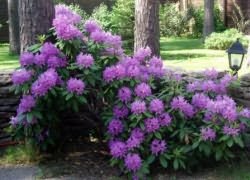
- forsythia - bright lemon foliage of this shrub will please the eye for several months; it looks very beautiful in group plantings and as a hedge;
- the euonymus with its incredible color leaves will peep even from under the snow cover, reminiscent of summer; the plant is unpretentious and requires only minimal bush formation;
- holly magonia is also an evergreen shrub for shady places, grows well in moist areas.
womanadvice.ru
Perennial ornamental plants - what you need to know about their cultivation?
Ornamental perennial herbaceous plants and perennials - is there a difference?
By perennials, gardeners often understand all plants that retain their decorative effect in one place for two or more years. Therefore, you will not make a mistake if you classify rose bushes as perennials. However, for ease of understanding, groups of perennial plants should be distinguished.
Perennial flowers are ornamental perennial herbaceous plants with beautiful flowers. This group includes peonies, asters, daylilies, snowdrops, poppies, carnations, irises, delphiniums, buttercups, mallows, phloxes, chrysanthemums, echinacea, evening primroses, lobelia, coreopsis and many others. This group also includes hosts and geyhers, although they are grown for their beautiful foliage.
Perennials are decorative herbaceous bushes, in which only the ground part does not become stiff. In this group, it is customary to take into account not only beautifully flowering, but also deciduous ornamental plants for the garden. Lavender, rosemary, sage, hyssop, heather, santolina, ferns - these and many other plants should be called perennials.
Decorative seedlings - this group includes perennials, the ground part of which is completely woody, for example, roses, spireas, barberries, lilacs, etc.. decorative trees can also be conditionally attributed to this group, although the conditions for planting and caring for them may differ radically.
In the photo - decorative perennial flowers, molomo.ru perennial flower, floratop.ru In the photo - ornamental perennial herbaceous plants, futuregarden.ru Photo of ornamental perennials herbaceous plants, koshkinsad.ru In the photo - decorative perennials, monstera35.ru
- Decorative flowers for the garden
- Photo of home decorative flowers
Decorative flowers - light-loving and shade-loving perennials
According to their classification, perennials are also divided according to the type of budding, the nature of the foliage, however, this information will be more useful to botanists than gardeners. What is useful for gardeners to know is the relationship of plants to the sun. From reference books and textbooks, we know that more than 3 hours of direct midday sunlight per day can be considered full sun, partial shade is about 3 hours of direct sunlight in the morning or evening and shading in the middle of the day. Good illumination throughout the day, albeit without direct rays, is also considered penumbra.
The shady zone indicates direct illumination. daylight about 3 hours in the middle of the day and limited light for the rest of the day. There is also the concept of rarefied, diffused light - the plant is illuminated throughout the day through not too dense foliage or other obstacles.
Decorative perennial flowers themselves tell gardeners about their preferences: gray-green, gray-gray, bluish, yellow, variegated, purple leaves, leaves with fluff or wax coating - these are sure signs that without bright sun you will not get them good growth and abundant flowering, because in such leaves there is much less chlorophyll. Asters, poppies, cornflowers, tulips will not grow without the sun,phlox, peonies,hyacinths, daylilies, daffodils…
Shade-tolerant plants grow well in both shading and indirect lighting. Many of them have time to fade before the trees are covered with leaves, and spend their dormant period in the shade. This group includes irises, astilbe, primroses, aquilegia, dicenters, blueberries and snowdrops, primroses ... Shade-loving perennials will help you out in those cases if you waved your hand at the shaded area under trees or a fence. Astilbe, angelica, honeysuckle, kupena, euphorbia, cornflower, ferns, primroses, hostas - with their help you can create whole compositions in shaded areas.
Perennial ornamental plants for the garden - general planting rules
The most important perennial flowers that will take up space in your garden will be their first year. It is during this period that you pay special attention to them, and your work will pay off handsomely. So, you have decided on the plants and purchased their seedlings. There are two scenarios for the development of events:
- seedlings came to you in a state of rest;
- perennials managed to come to life during the journey.
In the first case, if it is still frosty in the yard, remove the plants to a cool place, which can be an insulated balcony or even the bottom drawer of the refrigerator. If it is April-May on the street, a few days before planting, look at the roots or tubers of the perennial for dry and damaged roots, shorten the roots that have grown too much and dip the perennial for several hours in a growth stimulator, which will subsequently affect the good development of the root system.
Choose a suitable place for this or that plant in your flower garden, focusing primarily on the preferences and needs of a particular perennial in the sun. If you have poor soil on your site, try to fertilize it with compost and manure in the fall and dig it up.
The hole for planting the plant should be at least twice the size of the root system of the plant - then you can freely place it without bending the roots.
The perennial should be placed in the hole so that the root neck is a few centimeters below ground level. The roots should be evenly spread around the perimeter of the hole. After placing the perennial in the hole, cover the roots with earth and tamp the soil well, then water the plant abundantly.
In the second case, when perennials "woke up", before planting in the ground, let them get stronger in pots, regardless of the weather outside. When the time comes, dig a hole an order of magnitude larger than the clod of earth from the pot. When taking out a perennial, try to get by with minimal damage to the coma of the earth, or better without them at all. The plant should be placed in the hole with a clod, you just have to adjust the planting depth, guided by the root neck. Gently pour soil into the hole and tamp tightly, pour.
Many experts recommend planting perennial ornamental plants, respecting the space between them that an adult perennial will later need, that is, you must take into account their final height and intended shapes. In this case, you will have to contemplate at first a half-empty garden. If you do not want to observe such a picture, plant flowers more densely, so that for 2-3 years of their life there is no longer empty land between them. And even if one of the perennials begins to crowd out its neighbors, they can always be divided and seated.
Photo of plants for the garden, tsvetnik.info In the photo - ornamental plants for the garden, floribunda.ru Photo ornamental plants for the garden, 101dizain.ru Photo of ornamental flowers, 101dizain.ru Photo of ornamental plants in the garden, 101dizain.ru
General rules for plant care
Most perennial flowers and shrubs are unpretentious, but you should not leave your garden unattended. First, mulch the soil in your garden. In addition to its decorative function, mulching remains one of the simplest and most effective ways keep moisture in the soil. In addition, mulch suppresses the growth of weeds.
Secondly, feed the plants in your garden at least 3 times with complex fertilizers. The first time should be during the growing season, the second - during the ripening of buds or the opening of the first flowers, the third - at the end of flowering, for this case, fertilizers with potassium and phosphorus, without nitrogen, are best suited.
Third, water the plants as needed. Necessity means very dry weather where even a layer of mulch will be unable to retain moisture in the soil. Water under the root of the plant, there is no need to irrigate the leaves and flowers. Warm the water up in the sun cold water on leaves, may cause burns.
Fourth, go through the garden regularly with scissors or pruners and remove wilted or withered flowers. Try not to allow seeds to appear - perennials spend a lot of energy on "feeding" seeds and bloom less. In addition, pruning your flower garden will look much neater.
Fifth point - prop up the plants. Perennials can break under the weight of their own flowers or branches, or at least cling to the ground, which will not decorate your garden at all. Supports should be neutral colors so that they are invisible against the background of plants.
The sixth point is the timely division of bushes. Perennial flowers sooner or later grow to such an extent that they lose their decorative appearance and even stop blooming. For doing this simple operation, it is best to choose early spring or late autumn.
nasotke.ru
Perennial flowering shrubs, as well as the rules for planting and proper care for them
Today, none garden plot not without beautiful bushes. The same applies to park areas, squares and even small flower beds. You can dilute the boring image of gardens and plots with perennial shrubs. They help to delineate the boundaries of the garden, giving it a special showiness.
You can choose plants by size and color. In addition to beautiful flowering, shrubs also surprise with their exquisite aromas. In addition, these plants are not whimsical in care and are resistant to various diseases.
The best shrubs for the garden
Lilac. This is a diverse flowering shrub with about ten species. This plant is quite frost-resistant, so it can be grown in any temperate climate. The only drawback of the shrub is that after flowering it does not look attractive enough.
Spirea. This is an ornamental plant with fluffy flowers. Varieties of spirea have different flowering periods. Thanks to this, it is possible to ensure a continuous change in the garden colors shrubs. In turn, the aroma of the plant will attract various insects for pollination. After all, spirea is also an excellent honey plant.
Forsythia. It is a perennial shrub of the olive family. It has yellow flowers resembling bells. The uniqueness of this plant lies in the fact that it first blooms, and then releases leaves with young shoots.
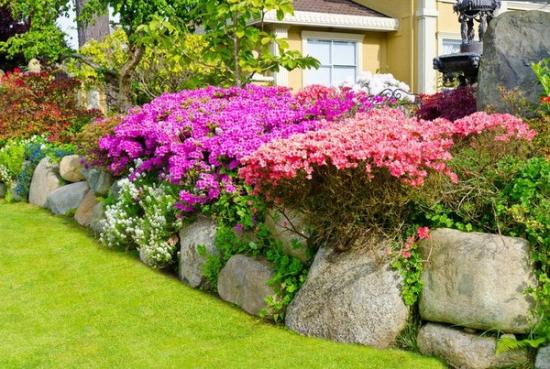
Decorative almond. This is a spring flowering plant. A shrub blooms 4-5 years after planting. Almonds do not require special care and grow quite quickly. When its old trunks die off, they are gradually replaced by new root offspring. In addition to all the plants listed above, you can decorate your site with such perennials as: barberry, weigela, wolfberry, keria, etc.
Planting and caring for perennial shrubs
Given the fact that ornamental plants grow in one place for many years, it is necessary to carefully choose the soil for them. If most of the shrubs are represented by light-loving forms, then it is better to plant them in shaded places.
For intensive growth plants, the ground must be pre-treated with organic fertilizers. As for planting, shrubs can be planted both in spring and autumn. In spring, planting should take place immediately after the snow melts, and in autumn - during leaf fall.
For autumn planting, holes need to be dug in the summer. The diameter and depth of the finished pit should be 0.6 m. If only sand is present in the soil, then a little clay should be added to it, on top of which fertile soil will be poured.
Video about a beautiful shrub for a garden - skumpii:
Planting should take place in cloudy weather. Plants ready for planting should have a strong root system. The age of seedlings should not exceed five years. Fresh seedlings should be immediately buried in prepared pits, otherwise the roots may dry out. After planting the plant, make a hole around it and pour two buckets of water into it.
Thus, the soil around the roots is compacted. The trunk circle of a watered plant can be mulched with peat, or fallen needles. Mulching the soil helps prevent moisture from evaporating.
Further care for planted shrubs consists in watering and cutting off weak and broken shoots. If the shoots are too long, then they also need to be cut. This is done in order to restore the physiological balance of the damaged root system. Throughout the growing season, plants need to be watered very often. Also during this period, you need to apply mineral fertilizers.
We create a garden of perennial shrubs
The correct creation of a garden or a flower garden with perennial shrubs takes place in several stages, for example, determining the style, distributing colors, etc. Style definition. The design style can be landscape or formal. Also, these two styles can be mixed by planting plants along the paths, in symmetrical lines. At the same time, in the center of the garden, you can place a composition in country style. Such a garden will need careful and regular maintenance.

Definition of a viewpoint. It is necessary to pay attention to those points from which the composition will most often be observed. First of all, it is necessary to take into account the color and texture of the shrubs. Blue colors should be placed close to the viewpoint, while bright colors are best perceived at a far distance. Shrubs with large flowers should also be placed away from the vantage point, and plants with small inflorescences should be placed in the foreground.
Color distribution. If the garden is monochrome, then only one color is taken as the basis, under which all other plants will be selected in the future. As a rule, the shades of all selected plants should correspond to the main color chosen.
Harmonious gardens combine two or three colors. The main thing is that these combinations are easy to understand. All perennial shrubs must be selected according to the flowering period in order to provide them continuous flowering. If a flower bed is planned on the territory of the garden, then when designing it, you should follow several rules. Most high grades plants should be placed in the middle of the flower bed. Further, the placement of shrubs takes place as it decreases.
Undersized flowers are planted along the borders. You also need to take into account the fact that the flower heads always turn to follow the sun. Therefore, so that the flowers do not turn in the opposite direction, it is best to plant those varieties that are least responsive to the sun's rays. These plants include: lupins, irises, delphinium, zinnias and marigolds.
In the process of planting perennial shrubs, a certain distance must be left between them, as they will grow over time. Also, when selecting plants, you need to pay attention to the fact that some varieties tend to close after dinner (bindweed). And such a flower as mattiola closes closer to the night. So that the flower bed can delight with its flowering all year round, some varieties of annuals can be added to perennials.
OgorodSadovod.com
Beautiful and unpretentious perennials: 12 of the best perennials | Favorite flowers
It is sometimes difficult for novice flower growers to navigate among the huge range of perennial flowers. How to choose the best of perennials? For beginners, it is especially important when the external beauty of a flower is combined with endurance.
We offer you 12 kinds of colors, which are actually a win-win.
These perennials are unpretentious and the most beautiful among such, they are suitable for a flower garden, easy to care for, but at the same time pleasing to the eye.
astilba
astilba(Astilbe) is an amazing plant. Do you still know many perennials that can bloom beautifully and luxuriantly in dense shade? It is to decorate the shady corners of the garden that astilba is most often used.
Astilbes are undersized and gigantic species - the height varies depending on the variety, starting from 20 centimeters and up to 1 meter.
Panicle inflorescences come in different colors - also depending on the variety - white, red and pink. Astilbe begins to bloom in July, and then continues for 10 weeks.
Soil moisture is important for astilba - keep an eye on this in order to water the plant on time.
Japanese anemone (autumn)
autumn anemones- flowers of stunning elegance. Perhaps these are the most beautiful perennials among the unpretentious. Large flowers with delicate petals flaunt on long peduncles. Anemones come in various colors - from white to bright red, bloom from the end of August. Look great not only in the flower garden, but also in the cut.
Anemones prefer fertile, humus-rich soils and partial shade.
In central Russia, various hybrids of the Japanese anemone (Anemone japonica) feel good.
Helenium
Helenium hybrid(Helenium) is one of the longest flowering and most abundant flowering perennials. Some varieties bloom almost all summer. You can choose varieties of geleniums so that these beautiful perennials bloom in your garden from June to October.
Geleniums love the sun, the choice of soil for them is not fundamental, the main thing is regular watering.
Recommended varieties - "Waltraud" (orange large inflorescences, height 80-100 cm, early variety), "Rubinzwerg" (ruby-red inflorescences, height 70-80 cm, medium early variety), "Septembergold" (bright yellow inflorescences , height 110 cm, late flowering variety).
Geranium is magnificent
Geranium is magnificent(Geranium magnificum) - especially valued among garden geraniums for its large flowers. Geraniums are indispensable in the garden, because they are able to bloom profusely in partial shade, they are usually planted under trees to decorate tree trunks, but they are also unusually good in mixborders, along with other perennials.
Geranium blooms for a short time - from May to June, but starting from the end of August, the leaves of this perennial are painted in beautiful reddish tones.
Geraniums are propagated by division of the bush or rhizomes. For species plants (not hybrids), propagation by seeds is also possible.
Kotovnik
Kotovnik(Nepeta) is often used in cold climates as a substitute for lavender, as it vaguely resembles it in the shape and color of the inflorescences.
Kotovnik is an unpretentious perennial, it is resistant to diseases, grows on any soil and in any light. But the most magnificent flowering is observed in catnip, which were planted in the sun. If after the first flowering the catnip is cut off, then it will bloom again.
Catnip is propagated by division of bushes or seeds.
Oriental poppy
Oriental poppy(Papaver orientale) impresses with the beauty and size of its flowers. There are early varieties of Oriental poppy that bloom in May-June, and late varieties that bloom in June-July.
This beautiful perennial requires a sunny location and rich nutrients soil rich in calcium.
After flowering, the entire aerial part of the poppy dies off, so seedlings of letniki are planted in its place at this time (should be taken care of in advance).
Cuff
Cuff- very hardy and unpretentious perennial. It grows on almost any soil and in any light - in the shade or in the sun.
The growth of the cuff should be controlled, as it can even be a little aggressive, growing and can crowd out other plants. However, if you prune it immediately after flowering, this will not happen.
The soft cuff (Alchemilla mollis) has decorative leaves and inflorescences.
sedum
sedum(Sedum) is notable for how it is able to decorate the garden not only in autumn, but even in winter.
Stonecrop flowers, red and pink shades, collected in inflorescences, begin to bloom at the end of August. Stonecrops need sunny areas and sandy soils (otherwise their stems may lie down).
Rudbeckia
Rudbeckia brilliant(Rudbeckia fulgida) decorates the garden in late summer and autumn. Like little suns, its orange-yellow inflorescences shine.
Some varieties of rudbeckia have the peculiarity of propagating by root offspring - the plant can spread over fairly large areas. But in flower beds, along with other hardy perennials, its growth is restrained.
Rudbeckia grows best in fertile, moist soils and a sunny location.
The best variety of this perennial is "Goldstrum". It has the largest flowers and a long flowering period - from July to September. Plant height - 70 cm.
yarrow
Yarrow meadowsweet(Achillea filipendulina) is a real champion in flowering duration. Its inflorescences-baskets on long peduncles adorn the garden from June to September.
Modern hybrids of this unpretentious perennial come not only in yellow flowers, but also in a variety of red and pastel warm shades. In addition, they are not as aggressive as the original species, their growth is quite easy to control.
hosta
hosta(Hosta) - perennial for a shady flower garden. Hosta is a classic flower garden partner for astilba (this perennial is number one on our list).
The hosta has fleshy large leaves, very decorative. Bell-shaped white or pink flowers appear briefly in June.
The best varieties of this perennial with beautiful leaves are Siebold's host Hosta Sieboldiana "Elegans" (blue-green leaves, height 60 cm) and Hosta Fortuna Hosta fortunei "Aureomarginata" (leaves with a yellow border, height 60 cm).
Sage
oak sage(Salvia nemorosa) - adorns the garden not only with its graceful inflorescences, "candles" of purple hues, but also with a stunning exquisite aroma.
Blooms throughout the summer, starting in June. Grows even in poor sandy soils. It is used in a variety of flower beds, including miniature ones, since the height of this beautiful perennial is small (30-50 cm).
The best varieties of sage: "Blauhugel" (blue inflorescences, height 50 cm), "Ostfriesland" (purple inflorescences, height 40 cm), "Markus" (purple-blue inflorescences, height 30 cm).
flowers.cveti-sadi.ru
Ornamental shrubs for a dacha garden, garden shrubs - photos and descriptions, expert recommendations, flowering ornamental shrubs for small and large gardens.
The ideal plant is shrubs for the garden- they are suitable for the territory with almost any area, unpretentious and easy to care for, and have a beautiful appearance. They delight the eye of the gardener and summer resident from early spring to late autumn and successfully perform the function of a hedge, giving the site a well-groomed appearance. By choosing shrubs that give abundant flowering, the gardener will get a lot of pleasure during the summer holidays and will be able, having renounced the bustle of the city, to spend time truly in a paradise.
Shrubs are tall and medium height, as well as low, coniferous or deciduous, fast-growing and moderate growth shrubs. The life expectancy of a shrub depends, as a rule, on the conditions of its growth. The shape of the crown of a shrub is the most important decorative quality of this plant for the architectural composition. The shrub can be a clear geometric or sprawling shape. The crown is natural and obtained by molding, as a result of the work of specialists on a shrub.
In the Mospitomnik Company nursery, specialists work on each specific tree and shrub offered for sale, giving it a beautiful shape or preserving its original appearance, growing all plants in the most favorable conditions. Therefore, our shrubs are the best choice for the garden, we suggest ordering ornamental plants from us inexpensively.
Ornamental shrubs for the garden - a great solution for those who love their garden
For any person, his garden is an unusual place. Here we can take a break from the hustle and bustle of city life, enjoy unity with nature, recharge with vital energy that is so necessary for all modern people. That is why everyone strives to ensure that this place is comfortable and beautiful. And, of course, no well-groomed garden can do without shrubs. Shrubs for the garden- one of the most important parts in terms of landscaping. According to landscape designers, ornamental shrubs are designed to smooth the transition from small herbaceous plants to slender plants. tall trees. Everyone likes them, they create a unique impression of the beauty and harmony of space, and their huge variety allows you to create according to your taste, embodying any landscape ideas, and create a little world with your own hands, in which all family members will be free and pleasant to relax.
To the delight of people, nature has created a huge number of a wide variety of plants, and shrubs are no exception. Whatever they are, differing from each other in shape and color, some bloom, others do not, some bear fruit - others do not, etc. But each of them is unique and beautiful in its own way. We offer you huge selection ornamental shrubs for every taste. We will help you make right choice, choose shrubs that are ideal for your garden and purchase plants that will become your favorites.
Ornamental shrubs for a small garden
If you have a small garden, then the first thing you should pay attention to is the flowering time of ornamental shrubs. In addition, it is important to take into account their size, choosing not particularly large specimens. The most rational in this case will be the choice of shrubs, the flowering of which will gradually replace each other. To do this, you need to choose from ornamental shrubs that bloom at different times of the year. Thus, by skillfully selecting plants, you will ensure that your garden will bloom all year round, pleasing to the eye.
Ornamental shrubs for a large garden
Happy owners of large gardens have much more opportunities for creativity. If you are one of them, then you are in luck, because you are free to choose your favorite ornamental shrubs of any size and shape, based on your tastes, preferences and aesthetic considerations. The only thing that can be recommended, as in the case of a small garden, is to think over the moment of seasonality of this or that shrub in order to be able to enjoy their beauties all year round.
Perennial ornamental shrubs
Another important factor that you should pay attention to when choosing an ornamental shrub for your garden is whether it is annual or perennial. Perennial are those ornamental shrubs that grow in one place for more than two years, while maintaining their decorative qualities. It is quite understandable that perennial shrubs are the most ideal option for you, since they do not need to be replanted annually. In addition, such perennials are the least whimsical in comparison with annuals. The most common flowering perennial shrubs include: Japanese quince, weigela, jasmine, hydrangea, garden hibiscus.
| Japonica |
Japonica. For example, Japanese quince is considered one of the most beautiful and brightly flowering shrubs that bloom in spring. She has bright red or bright pink flowers that just burn among the green leaves. In addition, it is quite frost-resistant.
Weigela. One of the first shrubs that will delight you with its many pale yellow, red and purple flowers in summer is weigela. This is a strong and unpretentious plant, the height and width of which reaches 3m. If you ask her well, then she can please you with repeated flowering at the end of summer.
But shrubs, equal in strength to the exhaled aroma, jasmine simply no. That is why many people like to keep it in their garden so much. In favor of jasmine, its unpretentiousness also speaks. He is not afraid of frost, wind or drought. But he still loves to live in the sun. At the end of summer, bright blooming hydrangea balls against the backdrop of juicy green leaves look simply gorgeous.
Hydrangea is also an excellent option when choosing a blooming perennial shrub, since it is extremely unpretentious and frost-resistant, it can be planted both in the sun and in the shade. Interestingly, the shade of hydrangea inflorescences is strongly influenced by the acidity of the soil - the higher it is, the brighter the colors. Hydrangea is extremely negative about lime soil, but in a humid environment it will feel perfect.
Let's take a look at what flowering shrubs it is best to choose based on the time of year in order to get the best result, in which the flowering of some plants will smoothly change the flowering period of others.
Ornamental shrubs blooming in spring
Spring is the time of the rebirth of nature, therefore, to observe flowering at this time is more natural and desirable than ever. Shrubs that bloom in spring include the most popular plants such as lilac, spirea, Japanese quince, Canadian shadberry, keria, forsythia, wolfberry, and almonds.
Lilac- one of the most beautiful and diverse flowering shrubs that bloom in spring. In addition, it is not whimsical at all, does not require special care, including constant watering. Lilac bushes can be used for any purpose, for example, when you need to highlight something or vice versa - hide it.
Spirea, or as it is also called meadowsweet, one of the most the best options choice for your garden, is also characterized by unpretentiousness, frost and drought resistance, grows very quickly, pleasing the eye for decades. It will suit any of the possible soils, does not require regular watering, and is simply irreplaceable in terms of decoration and garden design.
Japonica. Everyone has heard about such a shrub as quince, just like many people know the tart taste of its fruits, from which amazing jam is obtained. The most common is the Japanese quince. This shrub is also quite frost-resistant, but if the conditions are really harsh, then for the winter period, until about the end of April - the beginning of May, it will have to be bent to the ground, covered with burlap. Quince looks great both in a single copy and in group plantings, it will look especially impressive among the stones of an alpine hill or at the entrance to a garden house.
Irga canadian- an unusually beautiful shrub, ideal for creating hedges. It is also successfully used in solitary and curb plantings, and, picking up different types irgi, you can easily make very interesting decorative compositions.
Kerria- a very elegant ornamental flowering shrub with drooping branches and leaves, as well as bright yellow fragrant flowers. Differs in high winter hardiness. She is especially loved for her lush sunny-bright flowering, which, starting in spring, does not weaken until the summer itself, and then continues until the very frosts, although already less plentiful.
Forsythia one of the first to bloom in spring, when other plants are still naked. Flowers on it appear long before the leaves, while many small golden yellow flowers bloom on the bushes.
Almond- one of the most beautiful flowering shrubs, especially during its spring flowering. It also blooms very early when the plants around look rather dull after winter. Many also know that almonds bear fruit, and its fruits are very tasty and healthy. It is worth noting that, despite the high frost resistance of almonds, it is difficult to tolerate frost in the spring, during its flowering period.
Ornamental shrubs blooming in summer
Summer is simply created in order to enjoy the beauty of flowering plants. Of particular note are those blooming in summer shrubs such as mock orange, weigela hybrid, barberry, rose, wild rose, hydrangea, as well as tannery.
Chubushnik also called garden jasmine, because their blooms are very similar. This magnificent plant with wonderful fragrant flowers is becoming more and more popular in our gardens. It is unpretentious, easy to propagate, completely undemanding in care, and also very aesthetic.
Weigela hybrid not inferior in aesthetic sense to other shrubs, it has small beautiful flowers of various colors in the form of bells, as well as unusual leaves - green, with white bordering or purple, due to which the weigela bush looks truly chic both alone and in a group.
Barberry is a lush bush, the berries of which are very rich in vitamin C. A variety of sweets are prepared from them, they are used as a seasoning for meat dishes, pilafs. This is one of the most beautiful shrubs. But be careful - it has a lot of protective spikes.
Rose. There are probably simply no people who would not know or would not love roses. This is one of the most important, common and beloved by many flowering shrubs. The huge variability and aesthetic qualities of roses make it possible to create anything, enjoying their unique beauty and aroma.
Rose hip. No less than roses, wild rose is also known. This is not only a beautiful flowering, but also a very useful medicinal plant, from which tasty and healthy jam. Growing it is a pleasure, because it is frost-resistant and completely unpretentious.
Hydrangea or hydrangea - also a very beautiful plant, characterized by a very high moisture content. So think about it before planting it in your garden. As for its aesthetic qualities, we note that even one small hydrangea bush can completely transform your garden.
Skumpia tannery- a truly extraordinary plant, the benefits of which can be listed for a very long time. Its main advantages include: winter hardiness, beauty from spring to autumn, its large leaves and original fluffy inflorescences are especially good, many decorative and varieties with purple, resistance to urban pollution, drought resistance, durability. Surprisingly, skumpiya lives up to 70 years, and when good conditions- up to a hundred.
Ornamental shrubs blooming in autumn
The most successful shrubs blooming in autumn rightfully include paniculate hydrangea, cotoneaster splayed, mahonia, European spindle tree, mountain ash, wild apple tree, viburnum, cold-resistant abelia, hawthorn and wild rose.
Paniculata Hydrangea Phantom- one of the many varieties of hydrangeas, like all plants of this species, it is extremely moisture-loving. Otherwise, she is completely unpretentious. And it is called paniculate for the shape of the inflorescences, similar to a panicle. The color variety of this shrub is simply amazing in its diversity.
Cotoneaster brilliant- one of the representatives of the cotoneaster, - unpretentious and hardy, tolerates a haircut, which makes it very attractive to gardeners. It is often called the king of parks and squares, which is no coincidence, since its dense crown noticeably distinguishes it from all other shrubs.
mahonia earned love for itself due to the undemanding composition and acidity of the soil, it can easily grow on any, even heavy clay soil. As for the shortcomings, the plant is afraid of direct sun and constant wind. She does best in the shade.
Euonymus winged or "spindle tree", has large leaves, somewhat reminiscent of laurel leaves, which become bright and multi-colored in autumn. European euonymus has a dense root system, can grow on both wet and fairly dry slopes, loves alkaline soil. In addition, it is winter-hardy, grows quickly and tolerates a haircut well.
Rowan- one of the most popular plants in our country. Looking at her bright red clusters, especially when the frost has already hit, is a special pleasure. They seem to burn on the branches of a plant. Interestingly, mountain ash is beautiful at any time of the year, and caring for it is not difficult.
Decorative apple tree Royal Beauty- it is rather a small tree with a rounded, spreading or spherical crown. When it blooms, it is an extraordinary sight. The fruits of the wild apple tree can be very diverse in shape and color. This is a long-lived plant, completely unpretentious and easy to care for. Snow-white caps of flowers in spring, bright ripe berries, after which bitterness remains on the lips, and scarlet heart-bones inside - such a tree simply could not help but become a poetic symbol for our people.
Viburnum vulgaris Buldanez- no less popular in our open spaces than mountain ash, and its fruits are widely used in folk medicine. The decorative properties of viburnum are also quite high, and unpretentious care makes it one of the favorite evergreens.
Abelia cold-resistant - a very delicate flowering shrub with fragrant flowers that look like a bell or funnel. At good care, can grow up to 4 meters. It is very easy to maintain, it is easy to propagate, it blooms very beautifully, exuding an incredibly pleasant aroma.
Hawthorn is very fond of many gardeners for its decorative effect, these bushes can be used as hedge. Hawthorn fruits are a remedy recognized by folk medicine against cardiovascular diseases. This ornamental shrub has leaves that are almost invisible in summer, but in autumn they just burn, but when it blooms, it is covered with white, pink or red flowers.
Ornamental shrubs blooming in winter
Having shrubs in your garden that bloom in winter is very tempting for all gardeners without exception. You can recommend choosing a yew berry, derain, wild rose, as well as juniper.
Yew berry is an evergreen flowering ornamental shrub, perennial that can grow up to 30 meters. He loves shade, partial shade, as well as diffused sunlight. Prefers moist soil, so needs careful watering. Feels great in almost any type of soil. It tolerates shearing and shaping pruning.
Derain is a decorative flowering deciduous shrub of the dogwood family, a perennial, reaching a height of 4 meters. Likes direct sunlight, partial shade, as well as moist soil of any type. Light-loving, shade-tolerant and undemanding to the soil plant.
And the last one we'll talk about, juniper is a perennial evergreen shrub of the cypress family. A coniferous plant, hence many of its healing qualities. Height can reach 30 meters. Likes direct sunlight, moist to moderately moist soil. Decorate and ennoble any garden, fill it with a unique healing aroma.
Each garden has shaded areas where not all types of plants can grow. So that they do not look empty or unkempt, as often happens, they should be planted with shade-loving plants. In this article, we will look at which shade-tolerant garden plants are most often used to decorate a garden plot.
Plants that do not require a lot of sunlight do not always bloom luxuriantly and spectacularly, however, they can have picturesque shaped and beautiful foliage. It should be noted that shade-tolerant plants include some types of flowers, as well as shrubs and even trees. Therefore, further we will briefly get acquainted with all types of such cultures.
Flowers
Shade-tolerant garden flowers can add color to the shaded corners of your garden and thus make them less gloomy. The main thing is to choose the right ones and provide them with proper care.
When choosing such colors, it should be borne in mind that they are divided into two types:
- Perennials - able to grow and bloom for several seasons.
- Annuals - bloom one season, so they require an annual planting.
Each type of plant is good in its own way - with perennials there is less trouble, while annuals allow you to change the landscape on your site every year. Accordingly, it is up to each individual to decide which one to prefer.

perennials
When choosing shade-tolerant perennial flowers for the garden, you can give preference to the following types:
- Primroses are flowering plants that have a huge variety of species.. Thanks to this, you can choose a set of varieties so that flowering begins in early spring and ends in late autumn. As a rule, primroses are planted in groups under high ones.

Garden flowers - hellebore
- Hellebore is an evergreen culture of amazing beauty that blooms in early spring, in fact, this is where the name comes from.. It should be noted that these flowers are not only frost-resistant, but also drought-resistant. In one place, hellebore can live up to 10 years.
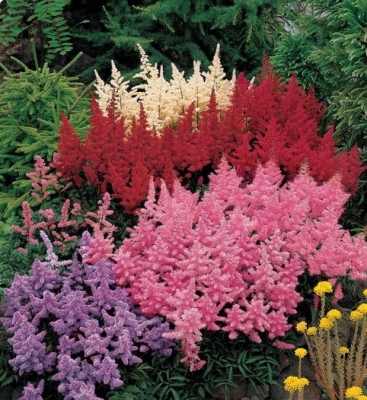
- Astilbe is a plant loved by many gardeners, which is distinguished by unpretentious care and flowering time.. Grows best in moist soils. Therefore, gardeners often plant astilbes with their own hands along the banks of decorative reservoirs.
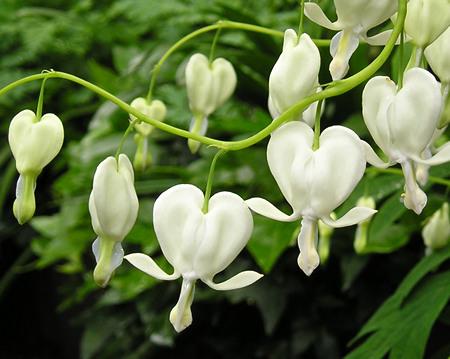
- Dicentra is a beautiful and at the same time unpretentious plant with an unusual heart-shaped flower.. At one time, the dicentra was very popular among flower growers, after which they forgot about it for a while. Now the fashion for the “broken heart” (another name for the flower) has returned again.
Advice!
Many of the above flowers can be grown from seeds, which are the least expensive.
The only thing to keep in mind is that seeds have a limited shelf life.
All of the above cultures are able to turn an unsightly plot of the garden into its highlight, striking with its attractive appearance.

Annuals
Those who like to change the palette of their flowering glades are better off choosing annual shade-tolerant flowers for the garden.
These include the following types:
- Balsam - is a long flowering, reaching a height of 50 cm. As a rule, the flowers of the plant are red or pink. In addition to decorativeness, the advantages of the plant include undemanding care.
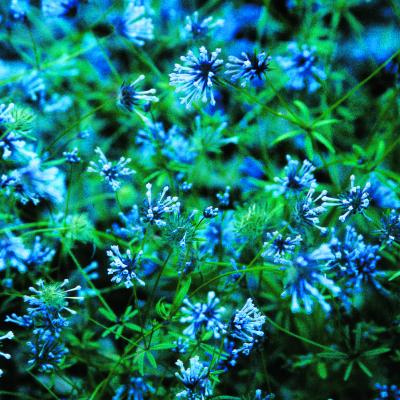
- Asperula blue - the culture is valued for the beautiful amethyst-blue color of the flowers, as well as the unforgettable delicate aroma. The plant is drought tolerant and very cold hardy. The only thing, for normal development, it is desirable to feed it with mineral fertilizers.
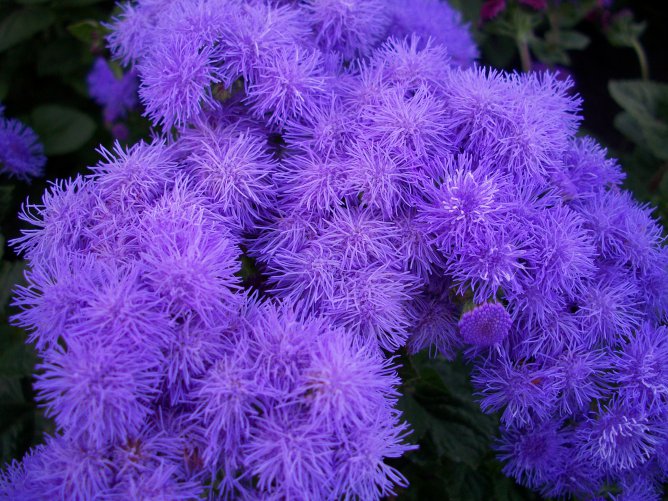
In the photo - lilac ageratum
- Ageratum - flowers loved by gardeners, which have a rich color and are adapted to any weather conditions. There are several colors of flowers, but the most popular are blue and lilac.
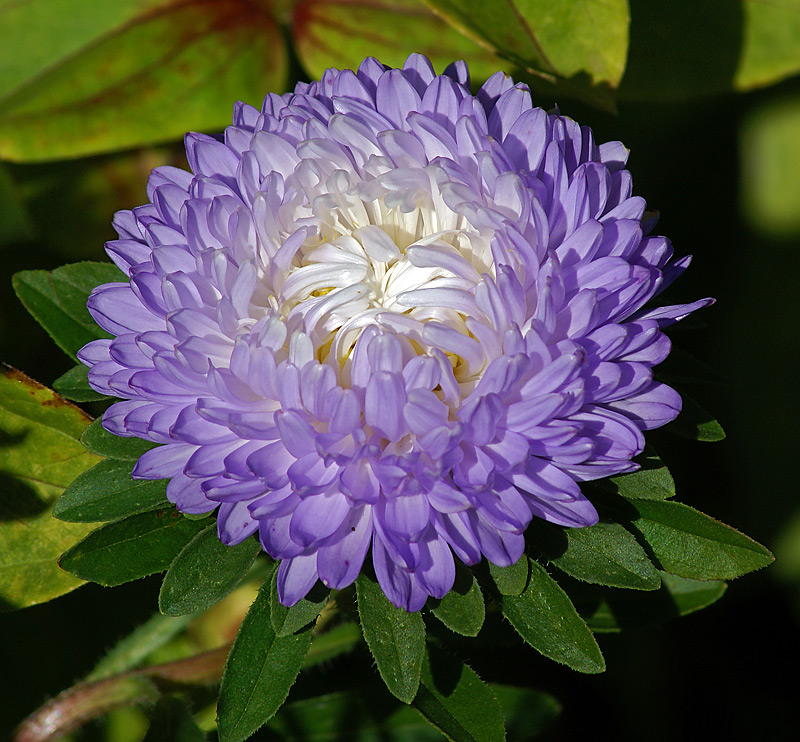
- Callistefaus - lush flowers resembling chrysanthemum inflorescences. Differ in a rich palette of shades.
In addition, there are many other beautiful and unpretentious flowers - such as kosmeya, aster, etc. Therefore, the choice depends on personal preferences.
Advice!
Often, shade is created by fences along which shade-tolerant climbing plants for the garden, for example, princes or clematis, can be planted.
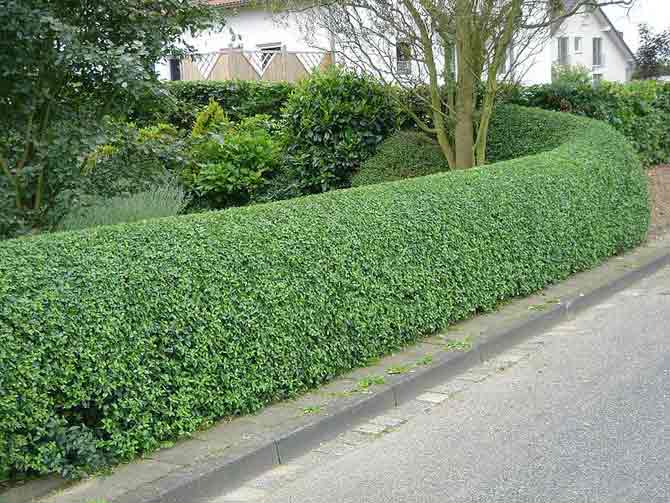
shrubs
Shade-tolerant shrubs for the garden will diversify shaded areas and give the landscape a more attractive and finished look.
Below we consider some of their most common types among gardeners and summer residents:
- Privet - This plant is usually used for hedges.. In addition to resistance to shade, the bushes are distinguished by their unpretentiousness to the environment. Therefore, the instructions for growing them are extremely simple.
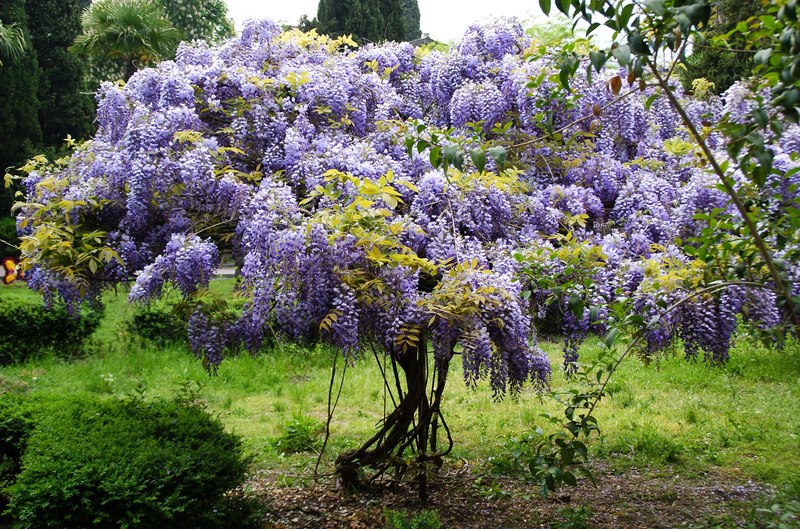
- Wisteria is a highly ornamental shrub that attracts with lush flowering.. It is often used for decorative walls, hedges and pergolas.
- Weigela is a shrub known to many gardeners that blooms beautifully.. As a rule, it is planted singly or in small groups.

- Decorative elderberry - culture attracts with its appearance not only at the flowering stage, but also at the fruiting stage. At the same time, it is resistant to various conditions. environment and undemanding in care.
- Junipers - these shade-tolerant coniferous plants for the garden have become a traditional plant, as they have excellent decorative effect.. As a rule, they are planted one by one, surrounded by flowers.
As we can see, different types of shrubs are used for different purposes, which allows you to fully form a landscape in shady areas of a summer house or garden.
Conclusion
To decorate the garden, you can use a variety of shade-loving plants, which in their beauty will not be inferior to sun-loving ones. By combining them, you will get a bright and varied landscape on your site, even in its darkest corners.
See the video in this article for more information on this topic.
An excellent solution for arranging a shady place in the garden is turning it into a cozy seating area. It will be so nice to be here in a moment of sweltering heat. To make it beautiful and comfortable in a shady corner, you will need to choose special plantings for it.
The brightness and beauty of shrubs of certain species helps to create not only beautiful site, but also the right mood for the day
All plants need light for good growth and development. But the requirements for the degree of illumination may be different. All plants can be divided into:
- Shade-loving;
- Shade-tolerant;
- Light-loving.
So a light-loving shrub planted in the shade will not die, but it will not please the eye with lush greenery. Therefore, for those parts of the garden where there is little sun, it is necessary to select shade-loving shrubs that can develop well in low light conditions.
Differences between shrubs and trees
Shrubs for landscape design are always in high demand. Therefore, in nurseries you will always be offered a large selection of these wonderful plants. Usually they are not expensive and you are guaranteed to buy attractive plants for your garden.
Between the bush and the tree there are transitional forms. The main difference is the presence of a central trunk, from which numerous branches depart. For example, hazel, holly, some willows, hawthorn can be grown both in the form of a tree and in the form of a bush. It all depends on pruning and growing conditions.
So the dark crimson forest beech, if it is periodically cut and adjusted for growth, turns into a shrub and can be used to form a beautiful hedge. Such a hedge for the winter will not shed its brown leaves. If it is allowed to grow freely, it will turn into a tree.
The choice of shade-loving inhabitants
To achieve the desired result, you must seriously approach the choice of shrubs. Some plant species require special soil composition. For example, rhododendrons, azaleas, and camellias love acidic soil.
Since the majority of shade-tolerant species come from the forest, when planting them, it is necessary to take care of the composition of the soil. The soil mixture should be fertile and neutral in acidity. In this case, the plants will easily take root and quickly turn into a lush bush.
It will be less expensive to choose shrubs for your garden that grow well in your area. Otherwise, you will have to spend a lot of time creating favorable conditions for them.
Think in advance about the place for planting plants, they should not be crowded. Choose shrubs based on their height. Shade-loving low-growing ornamental shrubs are good for decorating and strengthening embankments. The shape and size and flowering of most shrubs is controlled by regular pruning.
The space between the bushes can be filled with creeping plants or shade-tolerant flowers. This is both beautiful and will prevent excessive drying of the soil. Lilies of the valley will look very good. In spring they will delight with delicate and fragrant flowers, and in summer and autumn - with juicy, beautiful leaves. Lily of the valley has the ability to grow quickly, and you do not have to think about additional planting of them every year.
Twilight plants

A special decoration of shrubs are juicy, colorful fruits, which, however, are not always edible.
Many types of honeysuckle are shade-loving shrubs. Tatar honeysuckle deserves special attention, unpretentious and beautifully flowering, having many garden forms that differ in the color of the petals (from white to bright red).
No less attractive is the rare alpine honeysuckle with bright red fruits and a very dense crown.
Amazing "Poppy" can grow as a small tree. Edible honeysuckle is also popular, which is more valued for its early, piquantly bitter and very healthy berries.
Hazel and euonymus
The well-known common hazel grows well in the shade. For decorative purposes, it is better to use cultivated garden forms with different leaf colors.
Euonymus can be in the form of shrubs or small trees. They attract attention especially in autumn due to bright original fruits and beautiful leaf color. The warty euonymus has pink fruits and leaves. And the winged euonymus has crimson-red tones.
Viburnum and elderberry for a shady garden
Various types of viburnum also have a high shade tolerance. They are decorative at any time of the year. Viburnum vulgaris is a good choice for the garden. And its healing fruits help with many diseases.
Evergreen, blooming in winter, viburnum laurel is attractive with its white and pink flowers. Ideal for inexperienced gardeners.
Elderberry - many shrubs of this genus have long been used both as decorative and as food, and as medicinal plants. Elderberry red or racemose is particularly unpretentious, and is also able to repel mice well. The fruits of black elderberry are edible. This type of plant is desirable to plant in a place protected from the wind.
Hydrangeas, Magonias & Mexican Jasmine
Perfectly decorate the area in the penumbra of hydrangeas. They begin to bloom in early summer and until autumn. Their beautiful, large inflorescences will be attractive in dry bouquets. Not capricious and easy to care for - tree hydrangea. Panicle hydrangea is recognized as the most spectacular and suitable for growing, for example, in the middle lane.
Particularly noteworthy is its large-flowered form - "Grandiflora". The Bretschneider hydrangea looks beautiful with large white flowers, which then turn into purple.
Magonia holly is a compact evergreen shrub with beautiful shiny feathery leaves. In early spring, it is decorated with bright yellow inflorescences, and in early autumn - dark blue edible berries.
Shade-loving shrubs include Mexican jasmine with orange-scented flowers. After spring flowering, it can be cut short.
Cherry laurel, keria and cotoneaster
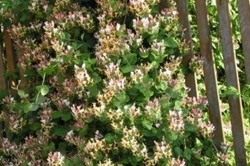
flowering shrub
Evergreen shade-loving shrubs include medicinal laurel cherry with glossy dense leaves. In June, it is decorated with tassels of fragrant white flowers. This is a fairly rare plant for gardens. middle lane due to low frost resistance. For reliable wintering, it must be covered.
Japanese keria is characterized by long spring-summer flowering, and sometimes repeated autumn. True, keria blooms better in the sun. But even in the shade it feels pretty good. It blooms with large yellow inflorescences.
The form "Pleniflora" is distinguished by magnificent terry petals. Keriya does not tolerate frost well and therefore it is better to cover it for the winter and protect it from the cold wind.
Cotoneaster refers to deciduous or evergreen plants. These shrubs are very diverse in shape and size. They can be six-meter trees, and stunted stalks.
Stay on the bush for the winter or fall off. Despite such differences, cotoneasters have common features for which they are valued and loved. All plants have very beautiful coloring of leaves in autumn and elegant fruits. Shrub blooms in May-June. White flowers emerge from pink buds.
What else to plant in the shade?
All species of this plant are unpretentious, do not require special care (except for pruning overgrown branches), and can grow anywhere. For the middle strip, male derain or dogwood is suitable. It is advisable to cover young plants for the winter.
You can also use for growing in the shade:
- Barberry Thunberg;
- Black elderberry;
- Mock orange crown;
- Viburnum viburnum and other types of shrubs with golden yellow foliage.
For growing hedges, Tatar honeysuckle and laurel cherry are well suited. If the place on the site is not only dark, but also dry, then it is better to plant Tatar honeysuckle and viburnum pride. This type of honeysuckle has forms with different colors of flowers, and viburnum has yellow-motley wrinkled leaves.
Coniferous garden guests
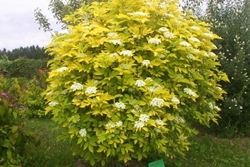
Plant several varieties of low-growing conifers in your garden. Coniferous trees are versatile and suitable for any garden. They can be used in a single landing and in various compositions.
Ephedra do not require increased attention and complex care. If you purchase hardy tree, then it will not need to be covered every autumn. Only in spring it is necessary to slightly shade from the scorching sun if the tree is not planted in the shade. Coniferous trees do not need frequent feeding.
Yew and juniper
The spiky yew is a coniferous plant and the most shade-tolerant of all trees. It got its name for the sharp spines at the end of the needles. Very slow growing, quite winter hardy. Small decorative forms of this plant winter best of all, but require protection from the aggressive spring sun. In our climatic zone, this is the only type of yew suitable for shearing.
Juniper is a useful genus of coniferous plants. To date, there are many undersized varieties. They grow and look very impressive. Creeping junipers are very loved and popular in America. And now they are conquering Russia.
There are junipers and medium and high sizes. The common advantage for all is unpretentiousness and frost resistance. They are not demanding on the composition of the soil and are better than other conifers able to tolerate drought. They love a haircut very much, therefore, in the middle of summer, creeping forms and plants in hedges are cut.
Shrub pruning
Many shrubs need pruning to encourage flowering. So deciduous shrubs blooming in spring are pruned immediately after flowering. It is necessary to cut off shoots with faded flowers to accelerate the growth of new ones.
After pruning, after a short time, young shoots appear with new buds and buds. Shrubs that bloom in late summer are pruned in spring. Immediately after such work, flowers appear on the growing young shoots. Pruning should be done shortly so that more new flowering shoots appear. Shrubs that bloom in winter are pruned immediately after flowering in early spring, removing damaged and dead branches.
lazy garden
Very often, many people dream of having a blooming, fragrant, bright and memorable site. But at the same time, it does not require constant attention, long-term care, endless weeding and loosening of the soil. Fiction? No. A dream garden can become a reality with very simple tools. And you don’t have to wait years for maturity and splendor. You just need to pay attention to the bushes.
To date, the choice of ornamental shrubs is so huge and varied that it allows you to set up a beautiful garden that does not require constant care. Shrubs are perfectly combined with each other and with almost all garden plants, so the design possibilities are limited only by your imagination.

shade-loving shrub
Shrubs do not lose their decorative effect throughout the season, and many even in winter.
Even with the predominant color of the foliage green, growing young shoots and leaves can be of various shades: bronze, pink, reddish, purple, etc.
Shrubs will create a wonderful backdrop for alpine slides and flower beds. And with proper selection, they will decorate the garden all year round.
Bushes for garden decor
In the garden, bushes can play a purely decorative role and delight the eye. They can bloom for a long time: from early spring to late autumn, and some in winter. Unusual variegated leaves of shrubs, bright berries and fruits, colored bark, evergreen leaf cover - all this will help the garden to maintain beauty and originality all year round.
And some bushes can even be grown in pots on the balcony, for example, lavender, arctic, camellias. The flower bed looks beautiful when plants of different heights are on it. This can be achieved using various types of shrubs.
If the bush has grown strongly, and it has become crowded, it can be transplanted. To do this, remember a few simple rules. Deciduous trees are transplanted between autumn and spring. Large shrubs need to be transplanted when they have just begun to shed their leaves.
It is better to place beautifully flowering shrubs in a shady or semi-shaded area of \u200b\u200bthe site. Do not forget to regularly feed your green pets with complex fertilizers, take care of them, and in gratitude they will delight you with long and lush flowering.
ornamental shrubs are widely used for landscaping, decorating house adjoining areas and park areas. Evergreen or profusely flowering plants are especially valued. They delight with their beauty for as long as possible and give the site an original unique look.
flowering shrubs it is best to plant on lawns, near terraces, at the entrance to the site. Beautiful living borders, backstage, hedges, ornamental arabesques and even unusual garden figures are created from evergreens. It is possible to use ornamental shrubs for zoning the space of the site.
One of planting benefits shrubs is the ability to create beautiful multi-stage cascades, when one plant is in harmony with another. The alley planting looks very nice, where the bushes are planted at an equal distance in one or more rows. Most best option- planting undersized species, and in the following rows of higher ones. The maximum height of such plantations is five meters.

What distinctive qualities should ornamental shrubs have?
First requirement- practicality. Such plants should be unpretentious, do not take much time to care for. One of the most important requirements is adaptation to the desired climatic conditions.
The second condition is aesthetic appeal. A planted shrub should delight with its beauty throughout the season. That is why evergreens are so valued, as well as those that bloom all summer. The most attractive shrub is made by bright flowers, unusually shaped or colored leaves, berries, and a pleasant aroma. Particular attention should be paid to the shape of the crown - in winter, without leaves, the shrub should look spectacular.
Shrub seedlings are most often sold in containers with a closed root system. In this case, they can be planted in the ground at any time, but still they take root best of all during the dormant period - in late autumn or early spring.
blooming in spring
You can always choose plants so that flowering will not stop from spring to autumn. Spirea, forsythia, tree-like peony, three-lobed almonds, keria, Canadian irga, wolf (Daphne), Japanese quince are suitable for the middle lane. Spring shrubs do not tolerate shady places and require open areas.

All varieties of spirea are very beautiful, among them there are early flowering and late flowering. Spirea Vangutta by the end of May is covered with elegant white flowers. For her tenderness and marvelous appearance, the people call her the “bride” for a reason. This shrub has a pleasant aroma, and lush flowering lasts two weeks.
Forsythia in early spring reveals bright yellow flowers resembling bluebells. The shrub is the first of all ornamental plants in the garden to be covered with flowers, it pleases with its flowering for more than three weeks.

The bushes of pale pink three-lobed almonds look especially noble and attractive. The mesmerizing flowers of this beautiful bush happy until mid-June.
White brushes of Canadian shadberry bloom in May, reminiscent of bird cherry flowers. Irga looks great at any time of the year, everything in it attracts with beauty: flowers, beautiful clusters of berries, and crimson leaves in autumn.
blooming in summer
In summer, the bulk of ornamental shrubs bloom, and it is simply impossible to choose which of them is the most beautiful. At this time, gentle jasmine, original barberry, charming hydrangea and bright hibiscus bring joy. A special word should be said about the weigel hybrid. This plant blooms in mid-May, blooms until June, while it can bloom again in August. During the period of abundant flowering, the bush is so covered with flowers that it turns into a large magnificent bouquet!
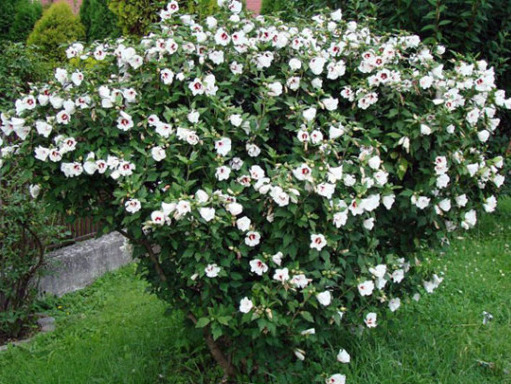
Hydrangeas can be decorated with huge white, pink, purple and burgundy flowers. The plant blooms in mid-summer and pleases with its colors until late autumn.

When it blooms, the air is filled with a bright, pleasant aroma. Mock orange (this is the second name for jasmine) grows easily in shady places, but it is preferable to plant it in sunny areas.

Shrubs for autumn and winter
Autumn compositions are made up of ornamental plants with beautiful leaves or unusual fruits. It can be panicled, mountain ash, European euonymus, wild apple, viburnum, and many other shrubs. Red clusters of rowan berries look especially beautiful against the background of bright yellow leaves. Euonymus pleases with crimson flowers in summer, and in autumn it is covered with rich purple foliage.
in winter the garden should not look dull and gray. To avoid this, you need to prepare in advance for the winter, plan the planting of decorative bushes so that the magic of living colors is preserved in the snow-covered garden. Here, plants with beautiful fruits that remain on the branches until spring come to the rescue. These are different types of wild rose with dense berries, red mountain ash and many types of evergreen shrubs.
Evergreen shrubs in landscape design
Ornamental evergreens are of particular beauty and value. Everything is beautiful in them: leaves, flowers, and berries. One period replaces another, and green leaves constantly delight with their freshness. Evergreen shrubs make magnificent hedges, backstage, frames. Very popular are: akuba, boxwood (buxus), juniper, strawberry tree (strawberry), callistemon, holly (holly). Most of them are shade-tolerant plants, for example, boxwood or holly. These shrubs can easily grow in shady areas, but still love the sun. Akuba, like other shade-loving plants, does not tolerate full sun very well.
The strawberry tree is a unique shrub that can have flowers and fruits at the same time in autumn. Strawberry grows very slowly, it can be planted both in sunny areas and in slight partial shade.
The holly (holly) is a symbol of Christmas and is traditionally used to decorate houses during the winter holidays. It blooms from October to December, easily tolerates shading, but it is not shade plant. The greatest contrast of colors in this plant appears precisely in the sun. Holly is especially beautiful in winter, when bushes with bright green leaves and beads of red, white, yellow, black and orange berries stand out clearly on the snow, which remain on the bushes all winter.
From a practical point of view, many evergreens are of interest as protective, dividing plantations. Boxwood, holly can be used as wind-protecting hedges and backstage, zoning the space of the plots.

Shade-tolerant shrubs and ornamental plantings
It's not always possible plant shrubs in an open sunny area or in a small penumbra. Therefore, shade-tolerant shrubs are planted in shady places, which can do without direct sunlight. These are dogwood, alpine currant, yew, which grow in any climate and are a worthy decoration of any site. shade-loving shrubs(for example, yew) lend themselves well to pruning, they can get a crown of any shape.
Advice. Ornamental shrubs should not be planted very densely, otherwise it will be difficult to deal with growing shoots. Proper pruning will allow you to form a beautiful crown, enhance growth and flowering. Therefore, you must always choose the right planting material, plan the landing sites, and follow the recommendations for proper care.



